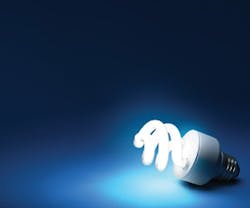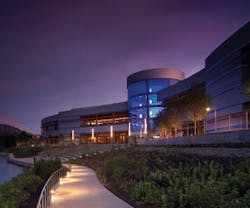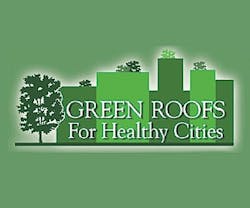Newsworthy
Safely Recycling CFLs and Other Energy-Efficient Lamps
CFLs and other energy-efficient lighting offer an excellent chance to save energy and reduce your carbon footprint. But, small doses of mercury in the lamps means they must be disposed of properly to avoid releasing harmful chemicals. Mark Tibbetts, director of recycling initiatives at the National Electrical Manufacturers Association (NEMA) in Rosslyn, VA, explains how recycling may be the answer.
Buildings: Why is it important to recycle CFLs and other energy-efficient lighting products?
Tibbetts: All fluorescent and most high-intensity discharge lamps contain a small amount of mercury, a naturally occurring element necessary for the energy-saving attributes of these lamps. Because mercury can be harmful to human health, it is important that lamps and other products containing mercury be properly managed at the end of life to protect public health and the environment.
Mercury is not released unless the lamp is broken, which is most likely to occur during transport and disposal when the lamp is thrown in a garbage truck or a dumpster. Because mercury binds to the metals and phosphor in a lamp while in use, a small fraction of the mercury in a lamp will be released as mercury vapor when it is broken.
While lamps are not a significant source of mercury pollution, the improper disposal of large numbers of lamps adds mercury to the environment. Recycling lamps, when conducted properly, captures almost all of the mercury, allowing it to be reused in the manufacturing of new energy-efficient lighting.
Buildings: What should building owners/managers know about handling used energy-efficient lighting products to ensure safety?
Tibbetts: Energy-efficient lamps (like all mercury-containing products) should be handled carefully. Broken lamps should not present a hazard if managed in accordance with basic clean-up procedures, including ventilating the area, removing all glass shards, and avoiding vacuuming, which can spread the mercury vapor.
Disposal of mercury-containing lamps by businesses is regulated by federal law under the Universal Waste Rule (UWR, 40 CFR Part 273). This rule prohibits most businesses from disposing of hazardous mercury-containing lamps in traditional municipal landfills. In most situations, recycling is the only viable disposal option for waste lamps. UWR imposes minimal requirements on generators (businesses) that recycle lamps – no permitting is needed and no special tracking or reporting is required.
Commercial building operators can arrange for recycling through a network of transportation and solid waste contractors. Material can be picked up in any U.S. community. There are also a number of lighting, maintenance, and other building contractors who will collect spent lamps and recycle them for customers. Lamp collection programs can be designed for all types of generators.
Buildings: What is NEMA doing to educate people about recycling energy-efficient lighting products?
Tibbetts: One of the primary vehicles is the newly revamped www.lamprecycle.org website – a one-stop shop for recycling information for both commercial and residential users of energy-efficient lighting. The manufacturers of mercury-containing lamps include the www.lamprecycle.org URL on the packaging of every mercury-containing lamp sold in the United States.
Buildings: What other recommendations do you have for the safe disposal of old energy-efficient lighting products?
Tibbetts: NEMA strongly encourages that all mercury-added lamps be recycled. Businesses may be required by law to do so, depending on state and local laws. A few jurisdictions require that residential lamps be recycled as well. Businesses should determine the volume of lamps they generate annually and implement a recycling program that matches their needs.
New Casino Opens on Former Industrial Brownfield Site
The new Rivers Casino in Pittsburgh has opened on a former brownfield site that was once a part of Pittsburgh’s “Steel City.” Las Vegas-based Bergman Walls & Associates Ltd. was architect of record and design architect for the casino, which is the first-ever casino in Pittsburgh. It features a riverfront location and million-dollar views of Pittsburgh’s three famous rivers.
The nearly 500,000-square-foot building includes a gaming floor with 3,000 slot machines spread out over 125,000 square feet with room to expand; 70,000 square feet of space for four restaurants, four bars, and a feature nightclub throughout the facilities, including outdoor terraces and patios; and a 3,800-space parking garage. Extensive use of glass brings outside views into the gaming floor, and the front façade adjacent to the riverfront curves along with the contour of the water’s edge. Cascading water features, natural livescape planters, and large drum chandeliers with diamond-shaped glass accentuate the interior.
Revised Smoke Hood Standard Improves Testing Criteria
The International Safety Equipment Association (ISEA) has received approval from the American National Standards Institute (ANSI) for ANSI/ISEA 110-2009, American National Standard for Air-Purifying Respiratory Protective Smoke Escape Devices. The standard covers a type of personal protective equipment called a “smoke hood” or “RPED,” which provides head, eye, and respiratory protection from particulate matter, eye irritants, and toxic gases and vapors commonly produced by structural fires.
Updates to the standard include the addition of an ocular leakage test and changes in sizing parameters. Additionally, the revision updates test procedures to provide criteria that will allow testing laboratories to generate reproducible results while removing restrictive language that could impede the testing process.
Historic Downtown Houston High Rise Earns LEED-EB: O&M Silver Certification
The 24-story, 543,000-square-foot multi-tenant office building, 919 Milam, in downtown Houston, has received LEED Silver certification by the USGBC in the LEED for Existing Buildings: Operations & Maintenance rating system. The historic landmark property, originally constructed in 1956, is owned by Transwestern Investment Co. and managed and leased by Transwestern.
To earn the certification, 919 Milam implemented a number of green design and operational features, including the installation of new restroom fixtures and CO2 sensors, implementation of green cleaning and building recycling programs, and improvements to reduce energy consumption and improve water efficiency. 919 Milam is the third Transwestern-managed property in Texas to achieve LEED-EB: O&M.
Sterling College to Build Green Dorms in 2010
Sterling College in Craftsbury Common, VT, used a $65,000 grant to complete a special topics course titled “Green Dorms,” taught by Sterling faculty and a Stowe, VT-based architectural planner in May as the first step to designing its first new student residency in more than 40 years.
During the course, the site work was determined and three design schemes were created by three teams of students. Now, with a recent Vermont state grant of $350,000 and the remaining $55,000 Canaday Family Trust grant, as well as other funds, including some matching money from a Department of Energy grant, a Sterling community building committee will begin working with the Cushman Design Group of Stowe, VT, to complete detailed plans and begin construction in March 2010.
Green Roofs for Healthy Cities Launches Professional Designation
Green Roofs for Healthy Cities (GRHC), the North American Green Roof Industry Association, launched the new Green Roof Professional (GRP) Accreditation Program at its 7th Annual International Greening Rooftops for Sustainable Communities Conference in Atlanta this past June.
GRP accreditation will verify that the designated GRP has attained the level of interdisciplinary knowledge needed in the design, installation, and maintenance of green roof systems. The 130 conference delegates were the first to complete the GRP Accreditation Exam, which covered the key areas of knowledge expected of a Green Roof Professional, including the five areas of concentration: pre-design, design, contract management, quality assurance and support, and maintenance. Many associated industry partners and subject matter experts provided GRHC with information on which the exam was based, including the American Society of Landscape Architects (ASLA), the National Roofing Contractors Association (NRCA), green roof industry members, and other roofing associations.
GRP accreditation also provides continuing education credits for AIA, ASLA, APA, and LEED.
National Construction Fatality Rate and Safety Incidents Decline Over Time
According to the Associated General Contractors of America’s (AGC) New Construction Association Analysis of Safety Data, the national construction fatality rate declined 47 percent and the number of recordable safety incidents dropped 38 percent since the federal government switched to a safety oversight approach known as “collaborative safety.”
The collaborative safety approach, which began in 1998, creates incentives for companies to find and fix safety problems before incidents occur while maintaining strong penalties for companies that let safety problems lag until someone is hurt.
Prior to the adoption of collaborative safety, there were 1.7 fatalities for every billion dollars invested in construction; today, that rate is 0.9. Additionally, the number of construction fatalities has declined by 17 percent. The data study also indicates that the construction safety incident rate fell from 8.8 per 100 workers to just 5.4 per 100 workers.
Lux Art Institute Receives LEED Certification
The Lux Art Institute in Encinitas, CA, has been awarded LEED certification by the U.S. Green Building Council (USGBC), making it the first LEED-certified art museum in San Diego County and the first art museum in California to be awarded LEED certification for new construction.
Lux achieved LEED certification based on a number of green design and construction features that positively impact the project itself and the broader community. The features include a giant barn door that opens to naturally cool down the studio area and provide views across the valley; design considerations that reduce the building’s overall energy usage by more than 10 percent compared to similar California buildings; the filtering of storm runoff water to prevent contamination of the ocean or lagoons; eco-conscious construction in which nearly 75 percent of construction waste was recycled or diverted from the landfill; materials used that consist of recycled content, with a significant portion that are manufactured or extracted within 500 miles from the site; and xeriscaped gardens that feature more than 750 native plants that require no special maintenance, fertilizers, or pesticides and use up to 50 percent less water and help prevent soil erosion.
IREM Survey Identifies Top Legal Issues Impacting Real Estate Managers and Landlords
A recently released survey sponsored by the Institute of Real Estate Management (IREM) and funded jointly by IREM and the National Association of Realtors (NAR) identifies current and emerging legal and liability issues impacting real estate management professionals. The study asked IREM members in leadership positions about legal problems confronting them and their colleagues, in addition to eliciting perceptions about how the current economic conditions are impacting these problems.
The survey showed that debt collection, slip and fall disputes, and frivolous lawsuits are the most significant current legal problems for real estate managers. Respondents said that among the economic factors adversely affecting debt-collection activities are the large number of retailers going out of business, growing lease defaults, and increasing numbers of residential tenants losing their jobs. Many respondents also believe that the economic downturn is exacerbating slip-and-fall disputes and frivolous lawsuits: Some suggest the depressed economy will lead to more people trying to cash in on slips and falls or opportunists looking for easy money by targeting landlords in frivolous lawsuits.
Survey respondents also predicted wrongful termination and fair housing as problems that are likely to become more significant over the next 2 years and weighed in on where additional training may be needed to better deal with these key legal issues.




